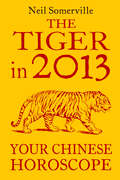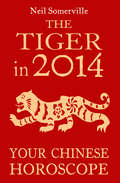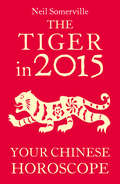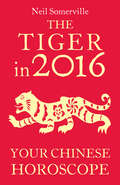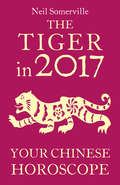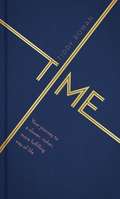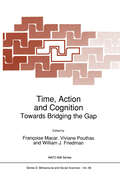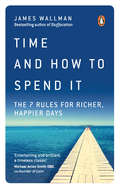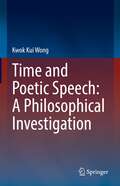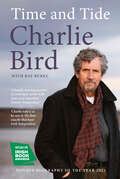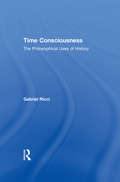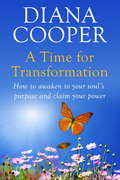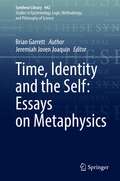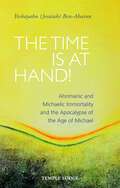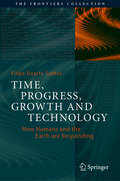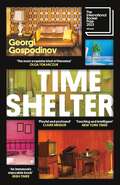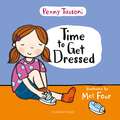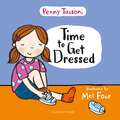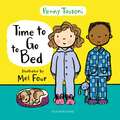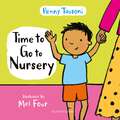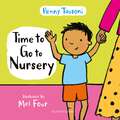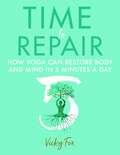- Table View
- List View
The Tiger in 2013: Your Chinese Horoscope
by Neil SomervilleWhat the year of the snake holds in store for the tiger. This complete guide contains all the predictions you will need for your Chinese zodiac sign to take you into the year ahead.
The Tiger in 2014: Your Chinese Horoscope
by Neil SomervilleThe year 2014 is the Chinese Year of the Horse – what will this mean for you? This complete guide contains all the predictions you will need to take you into the year ahead – a lively fast-paced year favouring ideas, innovation and personal growth.
The Tiger in 2015: What The Year Of The Sheep Holds In Store For You
by Neil SomervilleThe year 2015 is the Chinese Year of the Goat – what will this mean for you? This complete guide contains all the predictions you will need to take you into the year ahead – an interesting year offering scope, awareness and much possibility.
The Tiger in 2016: Your Chinese Horoscope
by Neil SomervilleThe year 2016 is the Chinese Year of the Monkey – what will this mean for you? This complete guide contains all the predictions you will need to take you into the year ahead – an interesting year offering scope, awareness and much possibility.
The Tiger in 2017: Your Chinese Horoscope
by Neil SomervilleThe year 2017 is the Chinese Year of the Rooster – what will this mean for you? This complete guide contains all the predictions you will need to take you into the year ahead – an interesting year offering scope, awareness and much possibility.
Time: Your journey to a slower, richer, more fulfilling way of life
by Tiddy RowanTime is the one thing that is shared by all of humanity, irrespective of wealth, health, race or credo; and one of the things that makes us individual is how we choose to spend it. It is one of the commodities over which we have most control, yet it is the asset we value the least. Isn't it time we took control over how we spend it, while we still can? Time will reward readers of lifestyle quests who seek a better, richer, slower, more fulfilling way of life. For anyone who has ever pondered the paradoxes of time and who is interested in looking at their world from a fresh perspective. Whether you want the encouragement to take time out on a life-scale or simply adjust your life to accommodate a timetable that suits you, this book will have plenty of inspiration, suggestions and tips to help you get the most out of your time.
Time, Action and Cognition: Towards Bridging the Gap (NATO Science Series D: #66)
by William J. Friedman VivianePouthas FrançoiseMacarThis volume is the outcome of the NATO Advanced Research Workshop on Time, Action and Cognition. which was held in Saint-Malo, France, in October 1991. The theme - time in action and cognition of time - was sparked by growing awareness in informal meetings between mostly French-speaking time psychologists of the need to bring together time specialists in the areas of development, motor behavior, attention, memory and representations. The workshop was designed to be a forum where different theoretical points of view and a variety of empirical approaches could be presented and discussed. Time psychologists tended to draw conclusions restricted to their specific fields of interest. From our own experience, we felt that addressing a common issue - possible relationships between time in action and representations of time - could lead to a more comprehensive approach. We are endebted to NATO for allowing us to bring this idea to fruition. We take this opportunity as well to express our thanks to Cognisciences ( Cognisud section) -- an active interdisciplinary research organization - for its financial backing and the CNRS for its scientific support.
Time and How to Spend It: The 7 Rules for Richer, Happier Days
by James WallmanIf the most precious thing we have is time, the most highly prized expertise should be knowing how to spend it well. Yet, busier than ever, do we really understand which experiences bring us joy and success, and which don’t?After all, we’ve learned how to spot the difference between junk foods and superfoods. When you discover the equivalent rules for time, it’ll change how you live your life.In his first book since the era-defining Stuffocation, cultural commentator and bestselling author James Wallman investigates the persistent problem of wasted, unfulfilling time, and finds a powerful answer — a revolutionary approach to life based on the latest scientific discoveries. At its heart is the inspiring revelation that, when you play by the new rules, you can actively choose better experiences.Bursting with original stories, fresh takes on tales you thought you knew, and insights from psychology, economics, and culture, Time and How to Spend It reveals a seven-point checklist that’ll help you avoid empty experiences, and fill your free hours with exciting and enriching ones instead.This life-enhancing book will show you how to be the hero or heroine of your own story. You’ll learn how to avoid WMDs (weapons of mass distraction), and discover the roads that lead to flow. You’ll get more out of every minute and every day; your weekends will fizz and your holidays will be deeply nourishing. You’ll not only be living the good life, but building a truly great life.
Time and Poetic Speech: A Philosophical Investigation
by Kwok Kui WongThis book analyzes the relation between the flow time and poetic speech in drama and rhetoric. It begins with the classical understanding of time as flux, and its problems and paradoxes entailing from Aristotle, Augustine, Kant and Husserl. The reader will see how these problems unfold and find resolutions through dramatic speech and rhetoric which has an essential relation to the flow of time. It covers elements in poetic speech such as affect, rhythm, metaphor, and syntax. It uses examples from classical rhetorical theories by Aristotle, Cicero, Quintilian, dramatic speeches from Shakespeare, as well as other modern dramatic texts by Chekhov, Beckett, Jelinek and Sarah Kane. This book appeals to students and academic researchers working in the philosophical fields of aesthetics and phenomenology as well those working in theater and the performing arts.
Time and Tide
by Charlie BirdA poignant and introspective memoir from Irish journalist and broadcaster Charlie Bird.
Time Consciousness: The Philosophical Uses of History
by Gabriel R. RicciTraditional metaphysics is hostile to the world of the senses. From Plato to Kant, philosophers have demanded that the sensuous and corporeal aspects of existence be circumscribed by rational conditions and properties. Without these, the sensuous is unintelligible. This elevation of the ability to reason as quintessentially human has obscured efforts to acknowledge the pivotal role the historical imagination has in grounding experience. In The Philosophical Uses of History, Gabriel Ricci explores the opposite tendency, from Vico to Heidegger, to emphasize temporal and historical foundations of human consciousness.Ricci's goal is to demonstrate the reciprocity of history and philosophy. He challenges the epistemological construction of the subject-object relationship and the facile dualism originating from Descartes. Arguing that consciousness must be defined in time and space, he shows how Vico's philosophy of humanity, with its historical epistemology, resurrects the practical implications of ancient philosophy's demand that knowledge and truth derive from a productive process. Ricci analyzes Heidegger's philosophy as the modern embodiment of the temporality of consciousness, and he demonstrates the origins of his particular interpretation of human existence in Rickert's and Windelband's delineation of the historical and natural sciences.Ricci links their influence to Heidegger's dissent over Ranke's objectivist methodology, which ended with Heiddegger's emphasis of the historical character of human existence. Finally, the author argues for the compatibility of Heidegger's early existential analytic and his later investigation of poetry and his critique of the technological idiom which had colonized philosophy. In doing so, Ricci highlights the metaphoric and figurative predisposition of mind as synthetic functions of historical consciousness.In offering a thoroughly temporal interpretation of mind, Ricci illuminates the relationship between philosophy and history, poetry, the cognitive sciences, and the natural sciences. This work will be of interest to philosophers, literary scholars, and cultural historians.
Time Consciousness: The Philosophical Uses of History
by Gabriel R. RicciTraditional metaphysics is hostile to the world of the senses. From Plato to Kant, philosophers have demanded that the sensuous and corporeal aspects of existence be circumscribed by rational conditions and properties. Without these, the sensuous is unintelligible. This elevation of the ability to reason as quintessentially human has obscured efforts to acknowledge the pivotal role the historical imagination has in grounding experience. In The Philosophical Uses of History, Gabriel Ricci explores the opposite tendency, from Vico to Heidegger, to emphasize temporal and historical foundations of human consciousness.Ricci's goal is to demonstrate the reciprocity of history and philosophy. He challenges the epistemological construction of the subject-object relationship and the facile dualism originating from Descartes. Arguing that consciousness must be defined in time and space, he shows how Vico's philosophy of humanity, with its historical epistemology, resurrects the practical implications of ancient philosophy's demand that knowledge and truth derive from a productive process. Ricci analyzes Heidegger's philosophy as the modern embodiment of the temporality of consciousness, and he demonstrates the origins of his particular interpretation of human existence in Rickert's and Windelband's delineation of the historical and natural sciences.Ricci links their influence to Heidegger's dissent over Ranke's objectivist methodology, which ended with Heiddegger's emphasis of the historical character of human existence. Finally, the author argues for the compatibility of Heidegger's early existential analytic and his later investigation of poetry and his critique of the technological idiom which had colonized philosophy. In doing so, Ricci highlights the metaphoric and figurative predisposition of mind as synthetic functions of historical consciousness.In offering a thoroughly temporal interpretation of mind, Ricci illuminates the relationship between philosophy and history, poetry, the cognitive sciences, and the natural sciences. This work will be of interest to philosophers, literary scholars, and cultural historians.
A Time For Transformation: How to awaken to your soul's purpose and claim your power
by Diana CooperWe all have the ability to transform our lives. In A Time for Transformation soul therapist Diana Cooper shows us how to awaken to our soul's purpose. Step by step, she takes us through the processes needed to change the way we think and live our lives, so that we can create a better reality for ourselves and others. Using examples from her own life and from her work with clients and in workshops, Diana looks at many key areas, including:· prosperity· abundance· success· careers· resolving conflict· healing hurts· our shadow self· past lives· claiming our power· relationships and much more. This practical and inspirational book shows us beyond doubt that we can transform our lives - and that the time to do it is now! For more information on Diana Cooper please visit www.dianacooper.com
Time, Identity and the Self: Essays on Metaphysics (Synthese Library #442)
by Brian GarrettThis volume contains twenty-four essays by the British/Australian analytic metaphysician, Brian Garrett. These essays are followed by four short dialogues that emphasize and summarize some of the main points of the essays and discuss new perspectives that have emerged since their original publication.The volume covers topics on the metaphysics of time, the nature of identity, and the nature and importance of persons and human beings. The chapters constitute the fruits of almost four decades of philosophical research, from Brian’s two award-winning essays, published in Analysis in 1983 and The Philosophical Quarterly in 1992, to his latest ideas about Fatalism and the Grandfather Paradox.This book will be of interest to students and professional philosophers in the field of analytic philosophy.
The Time is at Hand!: Ahrimanic and Michaelic Immortality and the Apocalypse of the Age of Michael
by Yeshayahu Jesaiah Ben-Aharon'The twenty-first century is the second, middle century of the three centuries of the present age of Michael, and it is the most decisive one. If humanity again misses Michael's goal, it will hardly be possible to recuperate from it, and human evolution will be derailed for a long time. The present age of Michael can therefore rightly be called 'the Apocalypse of the age of Michael'. – Yeshayahu Ben-Aharon In five lively, challenging lectures, Dr Ben-Aharon offers encouraging perspectives on the apocalyptic challenges facing humanity. The key Michaelic task for human beings today, he says, is to comprehend fully the new revelation of the etheric Christ. On the success of this depends humanity's resurrection from the abyss – from the grave of civilization. However, it can still be achieved, and the time is at hand! The author describes the global School of Spiritual Science's contemporary work to create a path to conscious recognition of the Christ and Michael impulses. Offering numerous fresh viewpoints into the trials of our time, The Time is at Hand! is an essential handbook for any serious student of anthroposophy. The talks (from 2017 and 2022) are titled: 'Ahrimanic Immortality, the Matrix and the Technological Singularity'; 'Michaelic Immortality'; 'The Two Apocalyptic Beasts and the Mystery of the Wound; 'Follow This Star'; and 'The Time is at Hand!'
Time, Progress, Growth and Technology: How Humans and the Earth are Responding (The Frontiers Collection)
by Filipe Duarte SantosThis book addresses the current challenges of sustainable development, including its social, economic and environmental components. The author argues that we need to develop a new concept of time based on inter-generational solidarity, which focuses both on the long- and the short term. The evolution of man's notions of time are analyzed from prehistory to modern times, showing how these concepts shape our worldviews, our ecological paradigms and our equilibrium with our planet. Practical approaches to dealing with the major medium- and long term sustainability challenges of the 21st century are presented and discussed. This is a thought provoking and timely book that addresses the main global socioeconomic and environmental challenges facing the current and future generations, using science-based analysis and perspectives. It presents an historical narrative of the advent of progress, economic growth and technology, and discusses the structural changes needed to co-create sustainable pathways. It provides hope for our future on Earth, mankind’s common home. António Guterres, Secretary-General of the United Nations This is an amazing, almost mind-boggling book. The author takes a look at the true whole, i.e., the development of the human enterprise since its very beginning. This enterprise is evidently a possibility under the boundary conditions of cosmological dynamics and natural evolution, but evidently also a highly improbable one. It is all but a miracle that the Earth system in its present form exists and happens to support a technical civilization. Will this civilization last long, will it transform itself into something even more exceptional, or will it perish in disgrace?Santos dares to address these grandest of all questions, equipped with a unique transdisciplinary wisdom drawing on physics, cybernetics, geology, biology, economics, anthropology, history, and philosophy. And he dares to dive into the deepest abysses of thinking, where categorial monsters like time and progress lurk. Thereby, he takes us on fascinating journey, during which we perceive and grasp things we have never seen and understood before. One of the best essays I have ever read. John Schellnhuber, founding director of the Potsdam Institute for Climate Impact Research (PIK) and former chair of the German Advisory Council on Global Change
Time Shelter: Winner of the International Booker Prize 2023
by Georgi GospodinovA GUARDIAN AND FINANCIAL TIMES BOOK OF THE YEAR'The most exquisite kind of literature... I've put it on a special shelf in my library that I reserve for books that demand to be revisited every now and then. 'OLGA TOKARCZUK, author of Drive Your Plow Over the Bones of the Dead'Could not be more timely... It's funny and absurd, but it's also frightening, because even as Gospodinov plays with the idea as fiction, the reader begins to recognise something rather closer to home... A writer of great warmth as well as skill'GUARDIAN'In equal measure playful and profound, Time Shelter renders the philosophical mesmerizing, and the everyday extraordinary. I loved it'CLAIRE MESSUD, author of The Woman Upstairs 'A genrebusting novel of ideas... Gospodinov's vision of tomorrow is the nightmare from which Europe knows it must awake. And accident, in combination with the book's own merits, may just have created a classic'THE TIMES 'Gospodinov is one of Europe's most fascinating and irreplaceable novelists, and this his most expansive, soulful and mind-bending book'DAVE EGGERS, author of The Circle'Touching and intelligent'NEW YORK TIMES'A powerful and brilliant novel: clear-sighted, foreboding, enigmatic'SANDRO VERONESI, author of The Hummingbird'An immensely enjoyable book which achieves depth with an affable narrative voice'IRISH TIMES In Time Shelter, an enigmatic flâneur named Gaustine opens a 'clinic for the past' that offers a promising treatment for Alzheimer's sufferers: each floor reproduces a decade in minute detail, transporting patients back in time. As Gaustine's assistant, the unnamed narrator is tasked with collecting the flotsam and jetsam of the past, from 1960s furniture and 1940s shirt buttons to scents and even afternoon light. But as the rooms become more convincing, an increasing number of healthy people seek out the clinic as a 'time shelter', hoping to escape from the horrors of our present - a development that results in an unexpected conundrum when the past begins to invade the present. Intricately crafted, and eloquently translated by Angela Rodel, Time Shelter cements Georgi Gospodinov's reputation as one of the indispensable writers of our times, a major voice in international literature. Georgi Gospodinov is one of Europe's most acclaimed writers. Originally from Bulgaria, his novels have won his country's most prestigious literary prize twice and have been shortlisted for more than a dozen international prizes - including the 2015 PEN Literary Award for Translation, the Premio Gregor von Rezzori, the Premio Strega Europeo, the Bruecke Berlin Preis, and the Haus der Kulturen der Welt Literaturpreis. He has won the 2016 Jan Michalski Prize for Literature, the 2019 Angelus Literature Central Europe Prize and the 2021 Premio Strega Europeo, among others.
Time to Get Dressed: Getting dressed explained in pictures that you can share (Time to....)
by Penny TassoniGetting dressed can be tricky at first, so lots of children need a helping hand. This delightful book shows children how some clothes keep them warm and dry, while others allow them to go swimming and splash in puddles! It also covers the trickier parts of getting dressed, such as buttons and zips.Time to Get Dressed shows children how getting dressed can be fun and interesting, through simple-to-read text and delightful full-colour illustrations by Mel Four. Children will be able to talk about colour, pattern and size, and even have a go at dressing themselves. From leading Early Years expert Penny Tassoni MBE, Time To... picture books use simple words and colourful illustrations to help young children understand all-important everyday skills. Featuring practical advice and tips for practitioners, carers and parents, these books will help you explore positive behaviour with children in a fun and friendly way.
Time to Get Dressed: Getting dressed explained in pictures that you can share (Time to....)
by Penny TassoniGetting dressed can be tricky at first, so lots of children need a helping hand. This delightful book shows children how some clothes keep them warm and dry, while others allow them to go swimming and splash in puddles! It also covers the trickier parts of getting dressed, such as buttons and zips.Time to Get Dressed shows children how getting dressed can be fun and interesting, through simple-to-read text and delightful full-colour illustrations by Mel Four. Children will be able to talk about colour, pattern and size, and even have a go at dressing themselves. From leading Early Years expert Penny Tassoni MBE, Time To... picture books use simple words and colourful illustrations to help young children understand all-important everyday skills. Featuring practical advice and tips for practitioners, carers and parents, these books will help you explore positive behaviour with children in a fun and friendly way.
Time to Go to Bed: The perfect picture book for talking about bedtime routines (Time to....)
by Penny TassoniNot all children enjoy going to bed, and a good bedtime routine can be hard to master. Time to Go to Bed explains to children why everyone needs sleep, and how being tired can make us unhappy or act in a really silly way!With simple text and delightful full-colour illustrations by Mel Four, this picture book helps children understand and follow the bedtime routine, from putting on pyjamas to settling down to sleep for the night. It shows children the many different places where sleep takes place, like cots, hammocks and even bird's nests. From leading Early Years expert Penny Tassoni MBE, Time To... picture books use simple words and colourful illustrations to help young children understand all-important everyday skills. Featuring practical advice and tips for practitioners, carers and parents, these books will help you explore positive behaviour with children in a fun and friendly way.
Time to Go to Bed: The perfect picture book for talking about bedtime routines (Time to....)
by Penny TassoniNot all children enjoy going to bed, and a good bedtime routine can be hard to master. Time to Go to Bed explains to children why everyone needs sleep, and how being tired can make us unhappy or act in a really silly way!With simple text and delightful full-colour illustrations by Mel Four, this picture book helps children understand and follow the bedtime routine, from putting on pyjamas to settling down to sleep for the night. It shows children the many different places where sleep takes place, like cots, hammocks and even bird's nests. From leading Early Years expert Penny Tassoni MBE, Time To... picture books use simple words and colourful illustrations to help young children understand all-important everyday skills. Featuring practical advice and tips for practitioners, carers and parents, these books will help you explore positive behaviour with children in a fun and friendly way.
Time to Go to Nursery: Help your child settle into nursery and dispel any worries (Time to....)
by Penny TassoniStarting nursery is a big step, so most children will feel nervous at first. This charming book explains what the day will look like, from saying goodbye to parents to meeting other children and learning new things. It shows children what exciting activities might be on offer, like dressing up in fabulous outfits or playing outdoors on tricycles.With simple-to-read text and delightful full-colour illustrations by Mel Four, Time to Go to Nursery helps children feel confident about going to nursery and reminds them that someone will always be there to help if they're unsure.From leading Early Years expert Penny Tassoni MBE, Time To... picture books use simple words and colourful illustrations to help young children understand all-important everyday skills. Featuring practical advice and tips for practitioners, carers and parents, these books will help you explore positive behaviour with children in a fun and friendly way.
Time to Go to Nursery: Help your child settle into nursery and dispel any worries (Time to....)
by Penny TassoniStarting nursery is a big step, so most children will feel nervous at first. This charming book explains what the day will look like, from saying goodbye to parents to meeting other children and learning new things. It shows children what exciting activities might be on offer, like dressing up in fabulous outfits or playing outdoors on tricycles.With simple-to-read text and delightful full-colour illustrations by Mel Four, Time to Go to Nursery helps children feel confident about going to nursery and reminds them that someone will always be there to help if they're unsure.From leading Early Years expert Penny Tassoni MBE, Time To... picture books use simple words and colourful illustrations to help young children understand all-important everyday skills. Featuring practical advice and tips for practitioners, carers and parents, these books will help you explore positive behaviour with children in a fun and friendly way.
Time to Repair: How yoga can restore body and mind in 5 minutes a day
by Vicky FoxWhen recovering from surgery and/or aggressive medical treatments we may need help with healing over and above rest and a good diet. Vicky Fox’s expertise in yoga for those with cancer diagnosis has given her practical understanding of how yoga can promote healing in the gentlest yet most fundamental ways but that patients are often held back by perceived lack of time to learn new skills and put them into practice. In this practical, illustrated guide to developing a yoga practice that supports healing, 5 minutes at a time, Vicky shows how to help the body restore balance, optimising the natural potential to repair following adverse events. Yoga is about becoming more flexible physically and psychologically/emotionally. The book builds on findings that it can help with insomnia, anxiety, bone density, inflammation, immunity, strength, balance and overall wellbeing – provided we can find the time.
Time, work and leisure: Life changes in England since 1700 (Studies in Popular Culture)
by Hugh CunninghamThis book traces the history of the relationship between work and leisure, from the ‘leisure preference’ of male workers in the eighteenth century, through the increase in working hours in the later eighteenth and early nineteenth centuries, to their progressive decline from 1830 to 1970. It examines how trade union action was critical in achieving the decline; how class structured the experience of leisure; how male identity was shaped by both work and leisure; how, in a society that placed high value on work, a ‘leisured class’ was nevertheless at the apex of political and social power – until it became thought of as ‘the idle rich’. Coinciding with the decline in working hours, two further tranches of time were marked out as properly without work: childhood and retirement. Accessible, wide-ranging and occasionally polemical, this book provides the first history of how we have imagined and used time.
